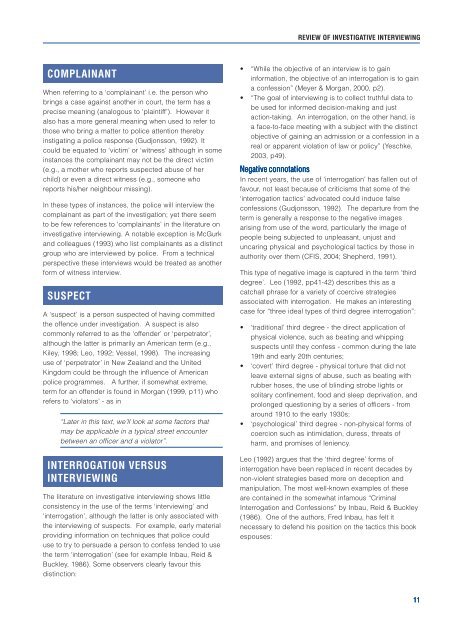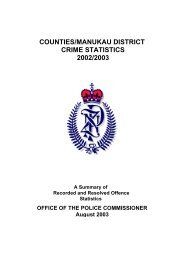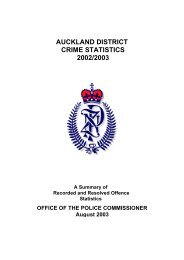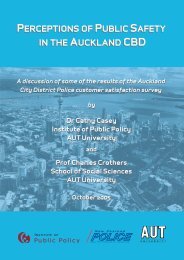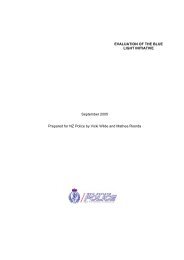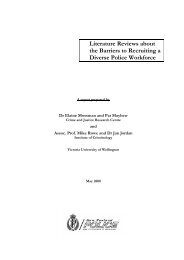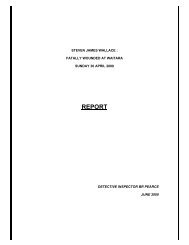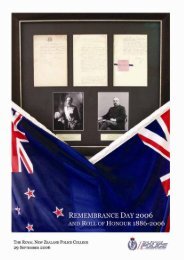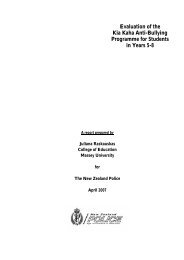Investigative interviewing: the literature - New Zealand Police
Investigative interviewing: the literature - New Zealand Police
Investigative interviewing: the literature - New Zealand Police
You also want an ePaper? Increase the reach of your titles
YUMPU automatically turns print PDFs into web optimized ePapers that Google loves.
REVIEW OF INVESTIGATIVE INTERVIEWING<br />
COMPLAINANT<br />
When referring to a ‘complainant’ i.e. <strong>the</strong> person who<br />
brings a case against ano<strong>the</strong>r in court, <strong>the</strong> term has a<br />
precise meaning (analogous to ‘plaintiff’). However it<br />
also has a more general meaning when used to refer to<br />
those who bring a matter to police attention <strong>the</strong>reby<br />
instigating a police response (Gudjonsson, 1992). It<br />
could be equated to ‘victim’ or ‘witness’ although in some<br />
instances <strong>the</strong> complainant may not be <strong>the</strong> direct victim<br />
(e.g., a mo<strong>the</strong>r who reports suspected abuse of her<br />
child) or even a direct witness (e.g., someone who<br />
reports his/her neighbour missing).<br />
In <strong>the</strong>se types of instances, <strong>the</strong> police will interview <strong>the</strong><br />
complainant as part of <strong>the</strong> investigation; yet <strong>the</strong>re seem<br />
to be few references to ‘complainants’ in <strong>the</strong> <strong>literature</strong> on<br />
investigative <strong>interviewing</strong>. A notable exception is McGurk<br />
and colleagues (1993) who list complainants as a distinct<br />
group who are interviewed by police. From a technical<br />
perspective <strong>the</strong>se interviews would be treated as ano<strong>the</strong>r<br />
form of witness interview.<br />
SUSPECT<br />
A ‘suspect’ is a person suspected of having committed<br />
<strong>the</strong> offence under investigation. A suspect is also<br />
commonly referred to as <strong>the</strong> ‘offender’ or ‘perpetrator’,<br />
although <strong>the</strong> latter is primarily an American term (e.g.,<br />
Kiley, 1998; Leo, 1992; Vessel, 1998). The increasing<br />
use of ‘perpetrator’ in <strong>New</strong> <strong>Zealand</strong> and <strong>the</strong> United<br />
Kingdom could be through <strong>the</strong> influence of American<br />
police programmes. A fur<strong>the</strong>r, if somewhat extreme,<br />
term for an offender is found in Morgan (1999, p11) who<br />
refers to ‘violators’ - as in<br />
“Later in this text, we’ll look at some factors that<br />
may be applicable in a typical street encounter<br />
between an officer and a violator”.<br />
INTERROGATION VERSUS<br />
INTERVIEWING<br />
The <strong>literature</strong> on investigative <strong>interviewing</strong> shows little<br />
consistency in <strong>the</strong> use of <strong>the</strong> terms ‘<strong>interviewing</strong>’ and<br />
‘interrogation’, although <strong>the</strong> latter is only associated with<br />
<strong>the</strong> <strong>interviewing</strong> of suspects. For example, early material<br />
providing information on techniques that police could<br />
use to try to persuade a person to confess tended to use<br />
<strong>the</strong> term ‘interrogation’ (see for example Inbau, Reid &<br />
Buckley, 1986). Some observers clearly favour this<br />
distinction:<br />
• “While <strong>the</strong> objective of an interview is to gain<br />
information, <strong>the</strong> objective of an interrogation is to gain<br />
a confession” (Meyer & Morgan, 2000, p2).<br />
• “The goal of <strong>interviewing</strong> is to collect truthful data to<br />
be used for informed decision-making and just<br />
action-taking. An interrogation, on <strong>the</strong> o<strong>the</strong>r hand, is<br />
a face-to-face meeting with a subject with <strong>the</strong> distinct<br />
objective of gaining an admission or a confession in a<br />
real or apparent violation of law or policy” (Yeschke,<br />
2003, p49).<br />
Negative connotations<br />
In recent years, <strong>the</strong> use of ‘interrogation’ has fallen out of<br />
favour, not least because of criticisms that some of <strong>the</strong><br />
‘interrogation tactics’ advocated could induce false<br />
confessions (Gudjonsson, 1992). The departure from <strong>the</strong><br />
term is generally a response to <strong>the</strong> negative images<br />
arising from use of <strong>the</strong> word, particularly <strong>the</strong> image of<br />
people being subjected to unpleasant, unjust and<br />
uncaring physical and psychological tactics by those in<br />
authority over <strong>the</strong>m (CFIS, 2004; Shepherd, 1991).<br />
This type of negative image is captured in <strong>the</strong> term ‘third<br />
degree’. Leo (1992, pp41-42) describes this as a<br />
catchall phrase for a variety of coercive strategies<br />
associated with interrogation. He makes an interesting<br />
case for “three ideal types of third degree interrogation”:<br />
• ‘traditional’ third degree - <strong>the</strong> direct application of<br />
physical violence, such as beating and whipping<br />
suspects until <strong>the</strong>y confess - common during <strong>the</strong> late<br />
19th and early 20th centuries;<br />
• ‘covert’ third degree - physical torture that did not<br />
leave external signs of abuse, such as beating with<br />
rubber hoses, <strong>the</strong> use of blinding strobe lights or<br />
solitary confinement, food and sleep deprivation, and<br />
prolonged questioning by a series of officers - from<br />
around 1910 to <strong>the</strong> early 1930s;<br />
• ‘psychological’ third degree - non-physical forms of<br />
coercion such as intimidation, duress, threats of<br />
harm, and promises of leniency.<br />
Leo (1992) argues that <strong>the</strong> ‘third degree’ forms of<br />
interrogation have been replaced in recent decades by<br />
non-violent strategies based more on deception and<br />
manipulation. The most well-known examples of <strong>the</strong>se<br />
are contained in <strong>the</strong> somewhat infamous “Criminal<br />
Interrogation and Confessions” by Inbau, Reid & Buckley<br />
(1986). One of <strong>the</strong> authors, Fred Inbau, has felt it<br />
necessary to defend his position on <strong>the</strong> tactics this book<br />
espouses:<br />
11


